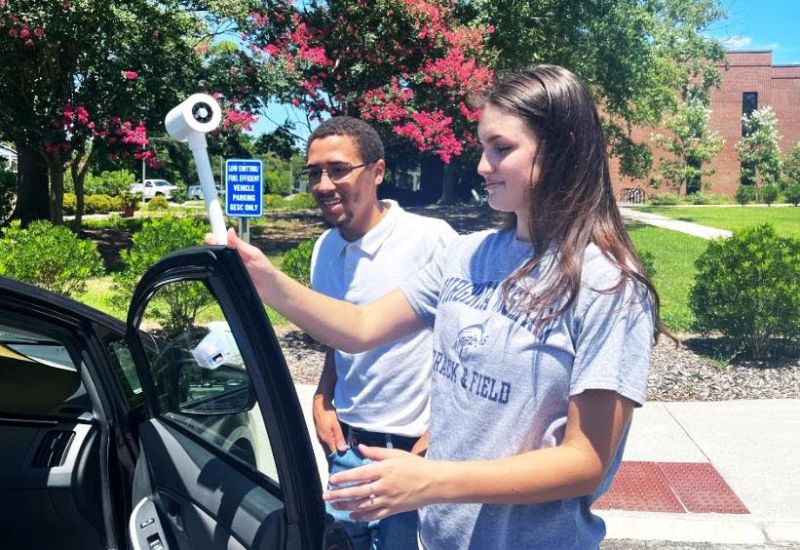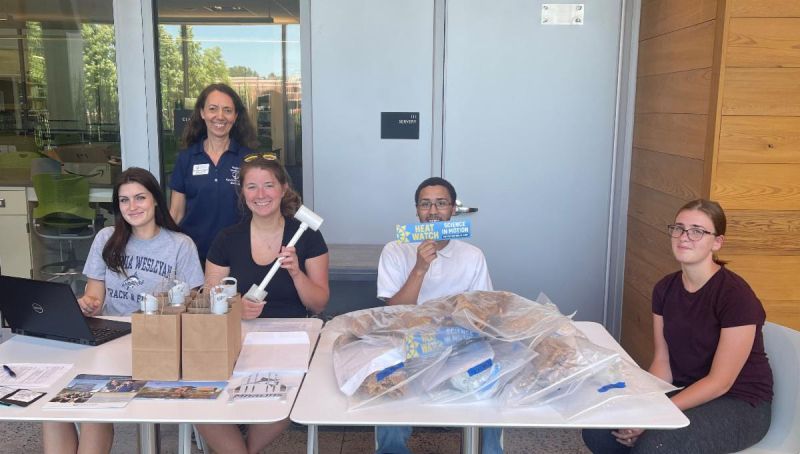Share this Story
Measuring Urban Heat Across Virginia
VFIC releases data collected during Heat Watch Campaign
 University News | March 29, 2022
University News | March 29, 2022
The Virginia Foundation for Independent Colleges (VFIC) has released data collected across Virginia during the Heat Watch Campaign. The data, gathered by Virginia Wesleyan and 11 other VFIC member institutions and Virginia State University, was collected as part of a collaborative project during the summer of 2021. The project brought together students, faculty and citizen scientists from 10 diverse communities to gather data on urban heat. Covering more than 300 square miles over areas ranging from Arlington to Abingdon, Virginia Beach to Winchester, the VFIC’s campaign focused on analyzing and understanding the impact of urban heat islands across the entire state of Virginia.
Virginia Wesleyan Professor of Ocean and Atmospheric Sciences Dr. Elizabeth Malcolm led the project at VWU. She and students organized citizen science research to measure the urban heat island across Virginia Beach. They engaged 30 volunteers which included VWU students, staff, alumni, and community members who participated in the project. The data they gathered as part of this initiative helped to identify communities that were disproportionately impacted by extreme heat and that should be targeted for interventions such as tree planting.
“Over 200 volunteers took part in the Heat Watch campaign,” says Matt Shank, president of the VFIC. “Volunteers used temperature sensors to traverse their study areas on a hot July 15 day by walking or driving at three standardized times of day: morning, afternoon, and evening. These data resulted in high-resolution heat surface maps, revealing temperature variations in our region.”
 Heat Watch volunteers collected highly detailed near-surface air temperature data for the purpose of correlating land uses such as asphalt parking lots and community green spaces, as well as topography, to temperatures. The project’s deliverables include maps of air temperature and heat index, along with datasets of participant temperature observations.
Heat Watch volunteers collected highly detailed near-surface air temperature data for the purpose of correlating land uses such as asphalt parking lots and community green spaces, as well as topography, to temperatures. The project’s deliverables include maps of air temperature and heat index, along with datasets of participant temperature observations.
“Colleges and universities that participated in the Heat Watch Campaign have already put the data generated by the project to good use,” says Shank. “Students and faculty members have used the data in research projects and presentations. The data has also been used to develop new curricula, as well as implemented in existing labs and lecture classes.”
VWU Professor of Earth Science Dr. Chris Haley is working with students to analyze the data using a geographic information system (GIS). They are creating a map of heat risk index, which combines the heat data with demographic data such as asthma and kidney disease, that can be used to identify neighborhoods with the highest risk from extreme heat. The risk map along with maps of tree cover and impervious surfaces are going to be used to identify neighborhoods to target for tree planting. These maps will be shared with the City of Virginia Beach and Lynnhaven River Now for use in future projects.
In addition, VWU’s Brynn Vandegriff and Marcus Smaltz, along with students from several of the other colleges involved, are presenting results from the research at the 2022 Environment Virginia Symposium this week.
Next week, Dr. Malcolm is presenting results from the project along with Dr. Karin Warren (Randolph College) and Dr. Michael Wolyniak (Hampden-Sydney College) at the 2022 Higher Education Climate Leadership Summit in a session titled " Virginia Heat Watch: Heat Mapping to Assess Vulnerability and Address Inequity in VA Communities."
“The VFIC is extremely grateful for its project partners and funders,” says Shank. “CAPA Strategies, Capital One, the Science Museum of Virginia, the Virginia Department of Forestry – each of these organizations used its expertise to make sure the VFIC’s research campaign was well run and highly productive. The data that’s now available will elevate the public’s awareness of the challenges we face and enable us to mitigate the negative impact of heat on urban communities.”
Learn more about the Heat Watch Campaign at vfic.org.

